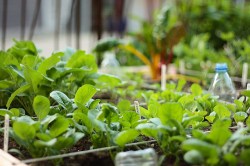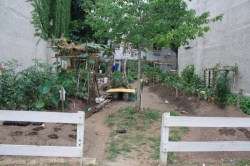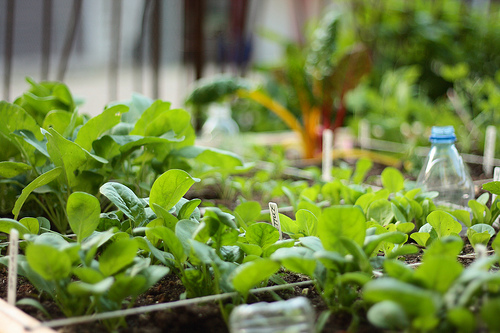
Photo by Matt Harris.
A couple of years ago, a community garden in my Chicago neighborhood got the boot. A university owned the land, and even a determined grassroots campaign could not stop it (cue Joni Mitchell) from turning 140 bountiful plots into a parking lot. The eviction, and similar ones taking place nationwide, highlight one of the biggest challenges facing urban agriculture: a lack of land tenure.
The story of displaced urban gardens is nothing new. Remember L.A.’s doomed South Central Community Farm? Or Rudy Giuliani’s 1999 fatwa on community gardens?
In the past, protests have coalesced around the threatened farm or garden. Now, a loose coalition of scholars and activists is taking a different tack. They’re proactively surveying gardens in New York, Philadelphia, and Chicago in hopes that hard data — servings harvested, revenues earned, and more — will make landlords think twice before summoning the bulldozers.
In New York, a geographer named Mara Gittleman is completing the third year of a garden survey called Farming Concrete. Gittleman recruited volunteers, mostly gardeners, to record the weight of the harvest (using kitchen scales) and the number and type of plants being grown. In 2010, the survey’s first year, she found that 67 New York gardens yielded 87,690 pounds of food, with an estimated value of $214,060.
Of course, 67 is a relatively small percentage of the total number of community gardens in New York; one estimate puts the number at 500. Gittleman’s count, though far from comprehensive, shows that garden surveys are both possible and relevant. “Once gardeners know the monetary value of their produce,” Gittleman says, “they can leverage these figures to gain visibility, access funding, and build capacity to grow even more.” Her findings have been a jumping-off point for sophisticated advocacy efforts like a research project out of Columbia University called The Potential for Urban Agriculture in New York City.
In Philadelphia, a garden survey is being driven by hopes of connecting threatened gardeners with legal aid. This July, I spent a morning with two University of Pennsylvania students, Michael Paci and Swaroop Rao, attempting to count the city’s community gardens. They were doing it the old-fashioned way, by visiting every single garden.

A squatter’s garden in Philadelphia. (Photo by Christopher Weber.)
Squatter gardens are common in Philadelphia. On the way to the target neighborhoods for the day, we passed scores of illegal vegetable plots, sometimes six or seven to a block. Though some had been tended for decades, they had recently begun to wane. A 2008 study found that the number of community gardens in Philadelphia was declining, despite rabid interest in urban agriculture.
Paci and Rao’s job was to determine whether the drop was continuing. Paci navigated a labyrinth of alleys and narrow one-ways while Rao penciled details on a xeroxed map. “This is essential knowledge, but it’s really hard to get,” Paci said over his shoulder. “If you don’t see someone at the garden, there is no way to call them. It’s difficult to follow-up.”
Along Ridge Avenue, a thoroughfare in north Philly, we pulled over to inspect several squatter gardens tucked between storefronts. As luck would have it, one of the gardeners, a Barbadian handyman named Dale, popped up. Dale showed us where he had painstakingly dug through the asphalt of a vacant lot to create room for hot peppers, cucumbers, and sweet potatoes. After explaining the survey, Rao interviewed him. How old was his garden? Who did he share the produce with? Where did he get water? …
Paci and Rao turned their survey data over to Amy Laura Cahn, a young attorney at the Public Interest Law Center of Philadelphia who hopes to build a practice around gardeners like Dale. She championed the survey as part of her Garden Justice Legal Initiative, which provides pro bono representation to gardeners facing eviction.
“Gardeners are Philadelphia’s vacant land stewards,” says Cahn. “Yet from a policy perspective, the city still views urban agriculture as a temporary activity.”
“The surveys project helps tell both stories — of the resurgent interest in gardens and the continued need to preserve them.”
Specifically, the research has revealed improving conditions for Philadelphia’s community gardens. “Gardens and farms have increased by over 100 in the past four years,” Cahn says. The survey data will help her make a legal case for gardens across the city.
These surveys add to a large body of research on the benefits of gardening on vacant land. A recent study by another University of Pennsylvania researcher found that planting gardens on empty lots reduced violence in the surrounding area. Further research is needed to tell whether it’s the gardeners themselves or their plants that are driving away gangbangers.
Like Cahn, another survey organizer sees a close tie between counting gardens and protecting them.
“We have to be able to demonstrate the power of gardeners as a constituency,” says Ben Helphand, who will lead a survey of more than 300 Chicago gardens in 2013. His team will use scales to tabulate harvest totals, as Gittleman did in New York. It will also complete in-depth studies of six representative gardens.
Helphand directs a nonprofit, NeighborSpace, whose mission is to safeguard Chicago’s community gardens. He expects the survey data will provide NeighborSpace — and agtivists in general — with a significant new tool.
“Elected officials listen to groups,” says Helphand. “We know there are thousands of community gardeners out there, but we’ve got to be able to prove it if we want to put policies that support urban ag in place.”



